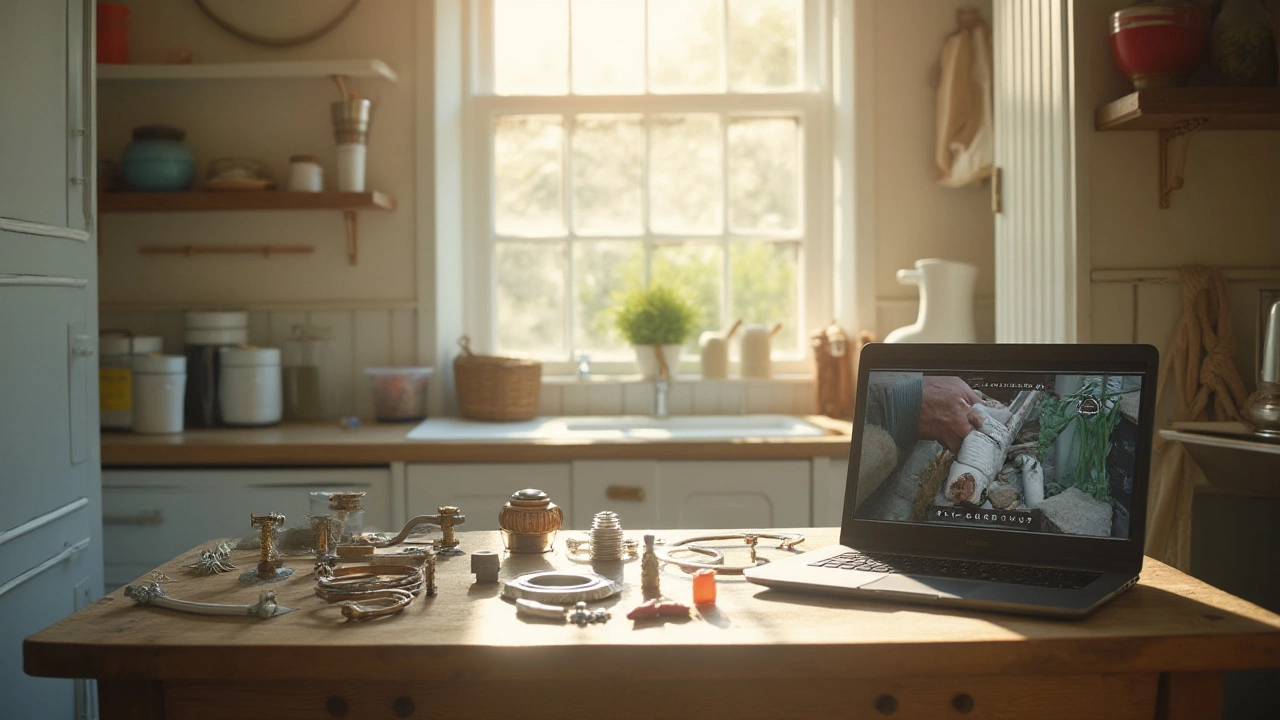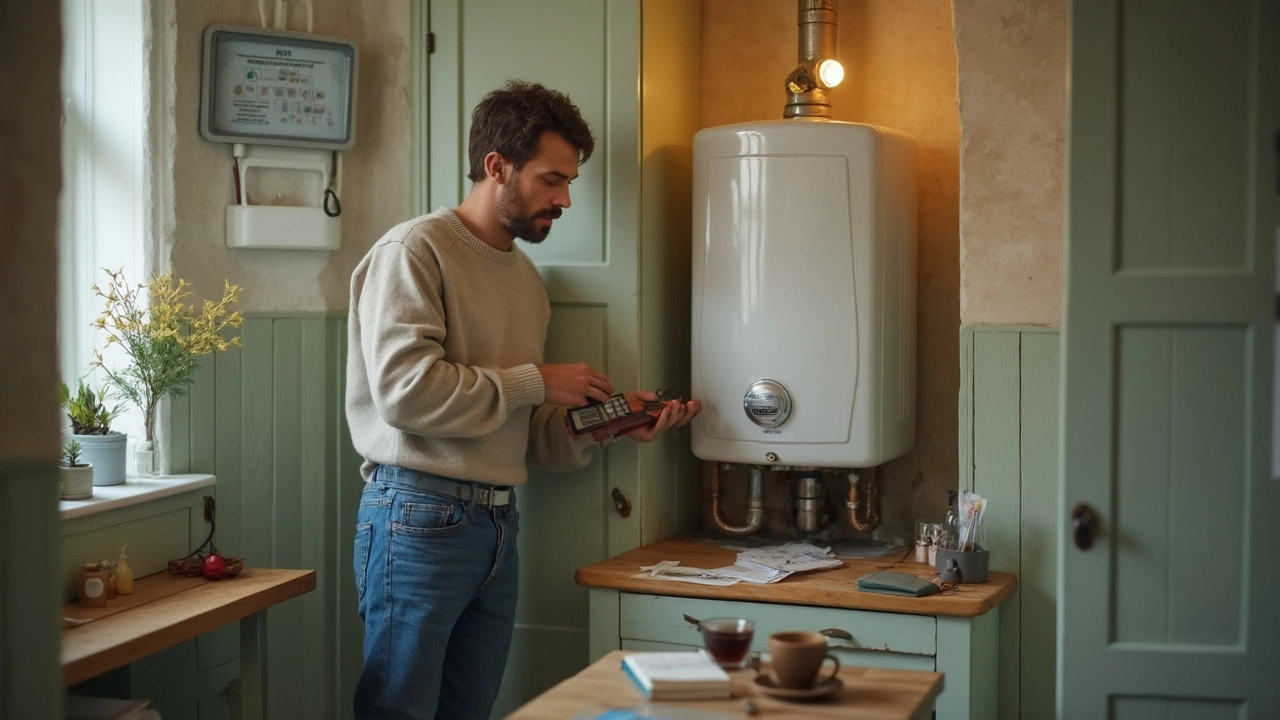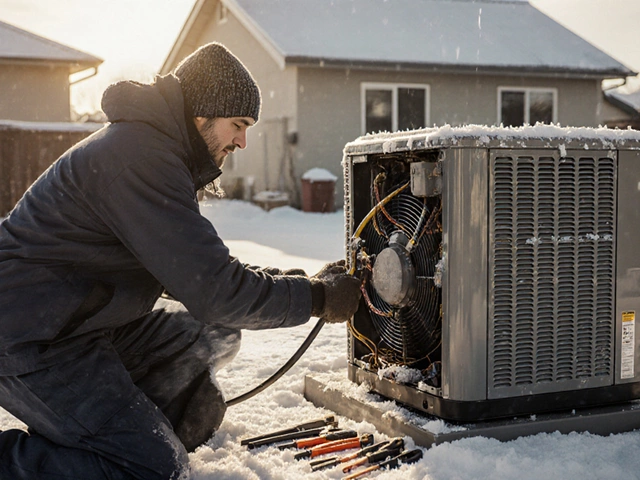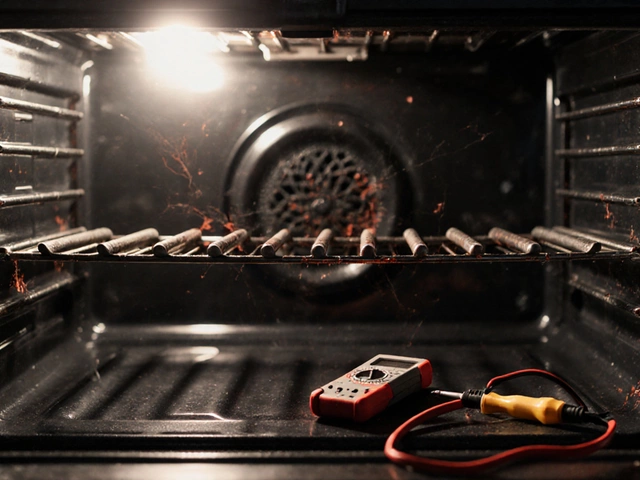Dreaming of a toasty morning shower only to find the water's gone chilly is one of life's small hurdles no one enjoys. For many folks, the thought of repairing a broken water heater sounds as mysterious as speaking an alien language. But wait, some problems may not require a degree in engineering or a fat wallet to handle.
In this narrative, we aim to decipher the chaos that lurks behind those metal tanks. Is it a simple fix, or is it a signal to consult the experts?
Let's unravel which bits you can tackle on your own and when it's a wiser move to call in the cavalry—that is, the professionals who ensure you don't turn a minor hiccup into a full-blown crisis.
- Understanding Water Heater Basics
- Common Water Heater Problems
- Pros and Cons of DIY Repairs
- Essential Tools and Safety Measures
- When to Call a Professional
Understanding Water Heater Basics
Water heaters might seem like complex beasts on the surface, yet understanding their basic ins and outs can offer more than just the charm of novelty. These contraptions are your home's hidden rock stars, tirelessly working behind the scenes to maintain your comfort. Fixing water heater issues begins with recognizing their heart—the tank. Most household water heaters work on a simple design: a tank that heats incoming cold water using either electricity or gas, and when you turn a tap, voilà, hot water. They look after all those warming needs, and despite their robust demeanor, they need a bit of TLC to ensure smooth operations. Each water heater typically contains a thermostat that regulates the temperature, usually set to about 60 degrees Celsius for energy efficiency and safety. A simple enough design, right?
Some fascinating discussions point out that the world initially turned a blind eye to the convenience these silent giants offer. A New York Times article suggests, "The modern water heater may well be the unsung hero of innovation today." Beyond the tank lies the anatomy that truly defines it: the dip tube brings cold water to the tank bottom, the heating components warm the water, and the pressure relief valve ensures no explosions occur under pressure. Quite the assembly of mechanical marvels!
Types of Water Heaters
Not everyone's water heater is identical, and here diversity spices things up. The two typical types are storage water heaters and tankless (or on-demand) water heaters. Storage models, generally larger, keep a hefty water supply on standby, heating it just in case. Tankless types forgo this reserve, instead heating water in real-time as it courses through the unit. The capacity to handle household size energy needs varies, as does their economy in terms of space and energy. Those pondering DIY water heater repair should acquaint themselves with the type they own, as fixing methodologies may differ.
For tech-enthusiast curious about consumption stats, consider this data: a typical storage tank heater is notorious for overdue energy demands, comprising nearly 18% of an average home’s electrical bill. In contrast, tankless water heaters could save the average household around 25% annually.
Becoming familiar with such mechanisms opens doors not only to nifty repair tricks but also to a fresh appreciation of these domestic allies. So next time you glance at the hefty cylinder in your basement, you might just nod in respect, knowing you grasp the fundamentals of its mission and are prepared to tackle the challenges it may pose.
Common Water Heater Problems
When it comes to water heaters, a number of issues can arise that might leave you scratching your head. One of the most common dilemmas homeowners face is a lack of hot water. This could be due to a myriad of reasons, ranging from a tripped circuit breaker to a broken thermostat. Sometimes it's the pilot light that's gone out in gas models, a relatively simple fix if you're comfortable relighting it yourself. Understanding the root cause is half the battle, turning a daunting task into a manageable one.
Another frequent issue is the water heater making strange noises. These can often sound like pops or cracks and are generally caused by sediment build-up in the tank. As your unit heats, the sediment traps water beneath it, causing those unsettling sounds. Regular maintenance, such as flushing the tank annually, can help combat this problem and enhance the heater's efficiency. But not everyone is aware of this simple upkeep task, leading to potential long-term damage.
Leaking is another significant concern that can originate from several places, like the storage tank or the pipe fittings. Leaks can be deceptive, starting small and growing when ignored. While some DIY handy folks might tighten the fittings or check for a faulty temperature and pressure relief valve, it's crucial to weigh the risk of damage if the tank itself is compromised. According to the U.S. Department of Energy, “Water heating accounts for about 18% of your home’s energy use.” Leaks can cause this percentage to spike unnecessarily.
Temperature issues lie at the heart of many water heater problems, be it water that's scalding hot or not heated sufficiently. Often, this relates back to a malfunctioning thermostat or incorrect temperature settings. However, it might also indicate a limited tank capacity, especially during those busy mornings when everyone wants a slice of the hot water pie. A simple test is to see if reducing the load makes a difference.
If you're noticing discolored or smelly water, the problem might be stemming from the heater's anode rod that’s corroding prematurely. A chemical reaction might happen, especially in water systems with a high concentration of sulfates, leading to that distinctive 'rotten egg' smell. Fortunately, replacing the anode rod is often a quick fix, provided you're comfortable with basic tools and have the supplies handy. This maintenance task can lengthen the life of your heater substantially.
"Maintaining a water heater isn't about complexity, but consistency. Regular check-ups significantly extend its lifespan," said Marcus Wellington, a renowned appliance repair expert. Continuing to use a faulty heater without addressing these issues can lead to costly repairs or the need for an entire replacement.
By recognizing these water heater maintenance issues early, and addressing them with the appropriate fixes, you can enjoy the comfort of hot water without unnecessary disruptions. Don’t overlook the importance of understanding your heater—the payoff is invaluable in the long run.

Pros and Cons of DIY Repairs
Embarking on a DIY water heater repair can feel like an adventure with its own set of thrills and chills. On one hand, getting down to business yourself usually saves a few bucks, which always feels like a victory in the never-ending financial chess game. Without a professional service bill, you'll have more in the coffers for other home projects or that new gadget you've been eyeing. Moreover, the sense of accomplishment that comes with successfully fixing that big, clunky tank is second to none—it’s essentially giving yourself a pat on the back for saving the day.
Another tick in the pro column is the opportunity to learn something new. By tapping into online resources, instructional videos, and perhaps a handy DIY guide, you might not only solve the current problem but also gain skills that will serve you well in other areas of home maintenance. If you've got the time and patience, handling water heater issues can turn into a very rewarding weekend project. However, it is crucial to note that not every water heater repair is suitable for the DIY approach. Experienced DIYers might have an edge here, but novices should heed caution.
Potential Risks and Challenges
Without doubt, venturing into DIY territory carries its own set of pitfalls. Water heaters operate on electricity or gas, both of which have a notorious reputation for being hazardous when mixed with inexperience. The dangers range from electric shocks to gas leaks, and it's crucial to respect these risks. A wrong move could not only endanger you but also cause further damage to the unit, potentially leading to more expensive repairs down the line. According to the American Society of Home Inspectors, fewer than 10% of water heater issues stem from problems that can be easily fixed by a non-professional. Even more, if there’s a complex component failure, you might simply lack the specialty parts or knowledge to address it.
‘A lot of people don't realize the complexity involved in these repairs,’ said John Lewis, a certified plumbing technician, ‘It's crucial to know when you're out of your depth and call in someone who knows the ropes.’
This highlights an essential aspect of the decision-making process: analyzing your limits objectively. While embarking on a DIY repair holds significant appeal, there's a thin line between learning and leaping into potential harm. It becomes prudent to assess the nature of the problem before diving into action. Simple issues such as a faulty thermostat or a reset problem can perhaps be tackled with relative ease, but consider professional help for anything more complicated than that.
| Aspect | DIY Repair | Professional Repair |
|---|---|---|
| Cost Effectiveness | High | Low |
| Time Consumption | Varies | Shorter |
| Expertise Required | Medium-High | High |
Ultimately, deciding to go DIY with your water heater should come after carefully considering the balance between saving cash and ensuring a high-quality, safe repair. When in doubt, investing in a professional’s expertise might actually save you money and stress in the long run. Surviving a water heater repair scenario without any hiccups will evolve as a key milestone, turning every repaired glitch into a proof of your practical prowess.
Essential Tools and Safety Measures
Tackling a water heater repair can be a gratifying project, one that not only saves you a few bucks but also rewards you with a sense of accomplishment. Yet, undertaking this task necessitates a perfect balance of tools and careful safety measures. Imagine you're embarking on a journey, and what better way to start than with a toolbox packed with essentials? A trusty wrench, a reliable multimeter, and a stout screwdriver are your closest allies. These rudimentary tools are your first stepping stones, allowing you to take apart defiant components and investigate suspicious connections.
There's no denying that working with electricity and water together is fraught with hazards. This is where safety protocols enter the picture. Prior to engaging in any repairs, ensure the power supply is switched off. It doesn’t matter if you are a DIY aficionado or a novice; this is non-negotiable. Don a set of electrical-resistant gloves, and keep a bucket and towel handy for any undetermined water spills. Moreover, understanding your limits is paramount. If at any point, it seems more complicated than anticipated, it's wise to take a step back—after all, safety is pivotal.
Reliable knowledge gathered directly from experienced hands can make a world of difference. As seasoned plumber John Doe once said, "A tool in the hand of a cautious individual is as mighty as the person wielding it." His words remind us of the importance of knowing not just the tools but how to use them responsibly. Many professionals emphasize the importance of patience and double-checking every step you take. As seen in various online forums and repair guides, simple oversights can lead to bigger dilemmas.
Suggested Tools Checklist
- Wrench – Essential for loosening and tightening bolts.
- Multimeter – Crucial for testing electrical circuits and connections.
- Screwdriver – Perfect for dissembling panel covers and screws.
- Safety Gloves – Vital for providing protection against electrical shocks.
- Bucket and Towels – Handy in dealing with unexpected leaks or spills.
According to industry data, approximately 20% of household accidents are linked to improper DIY repairs. This statistic underscores why safety should be your top priority. Not only does it protect your well-being, but it also ensures the success of your repair attempts without leading to further complications. Whether it’s as simple as replacing a heating element or inspecting a suspicious leak, taking precautions today ensures you have a warm bath tomorrow. Remember, the path to mastering DIY water heater repair begins not just with knowledge but also with respect for safety and preparation.

When to Call a Professional
Tackling a water heater repair might seem like an exciting project, a chance to put on your handyman cap. But sometimes the task at hand might just be a bit too intricate for a typical Saturday afternoon DIY. Knowing when to step back and call in a professional can save you both time and possibly prevent a bigger catastrophe. One key indicator is the extent of the problem. For instance, if the issue lies with the electrical components or there's a gas leak, it's time to hit the brakes. Water and electricity form a dangerous duo, and without proper training, meddling in these areas can lead to serious hazards. Gas leaks, on the other hand, pose not only a risk of fire but also introduce toxic dangers that are best left to experts keen on safety protocols.
Another red flag is recurring issues. If you've repeatedly tackled the same glitch only for it to reappear like an unwanted guest, it may signal a more complex underlying problem. Rather than engaging in a cycle of temporary fixes, this might warrant a professional's keen eye to diagnose and mend the root cause. Efficiency in repairs is not just about solving obvious issues but understanding their intricate web.
Additionally, some water heater units might still be under warranty. Tinkering with them independently could void such warranties, turning what was once a cost-covering relief into a sunk cost. Confirming the warranty terms and seeking authorized repair services can preserve those warranty benefits.
"When energy consumption spikes or odd noises emerge from their heaters, most people instinctively know who to call," says Alice Tan, renowned home appliance expert. "But with some persistence, we can identify the line between manageable DIY and certified professional intervention."
So, how do you decipher those telltale signs? Keep an ear out for unusual sounds or observe any out-of-the-norm behavior, such as fluctuating water temperatures or persistent water leaks. If water turns rusty or there's a strong sulfur odor, it might hint at an internal corrosion problem, signaling that it's time for the pros to step in.
The task also can become unaffordable if you consider the costs of acquiring the right tools and replacement parts for DIY. Often, professionals come armed with the necessary tools and can source parts at a more cost-effective rate. Should the initial DIY estimate spiral, pausing and reaching out to a professional can be a financially sound decision.





